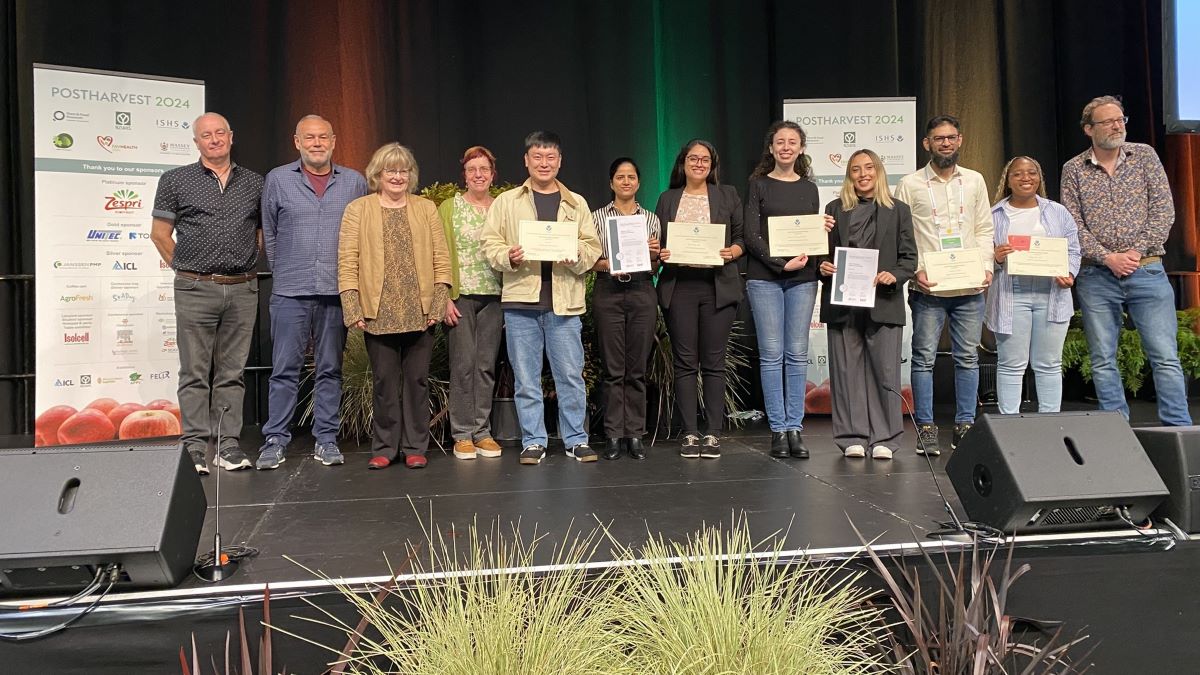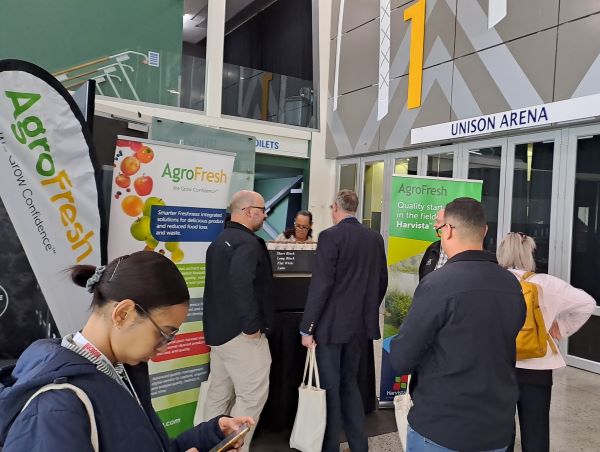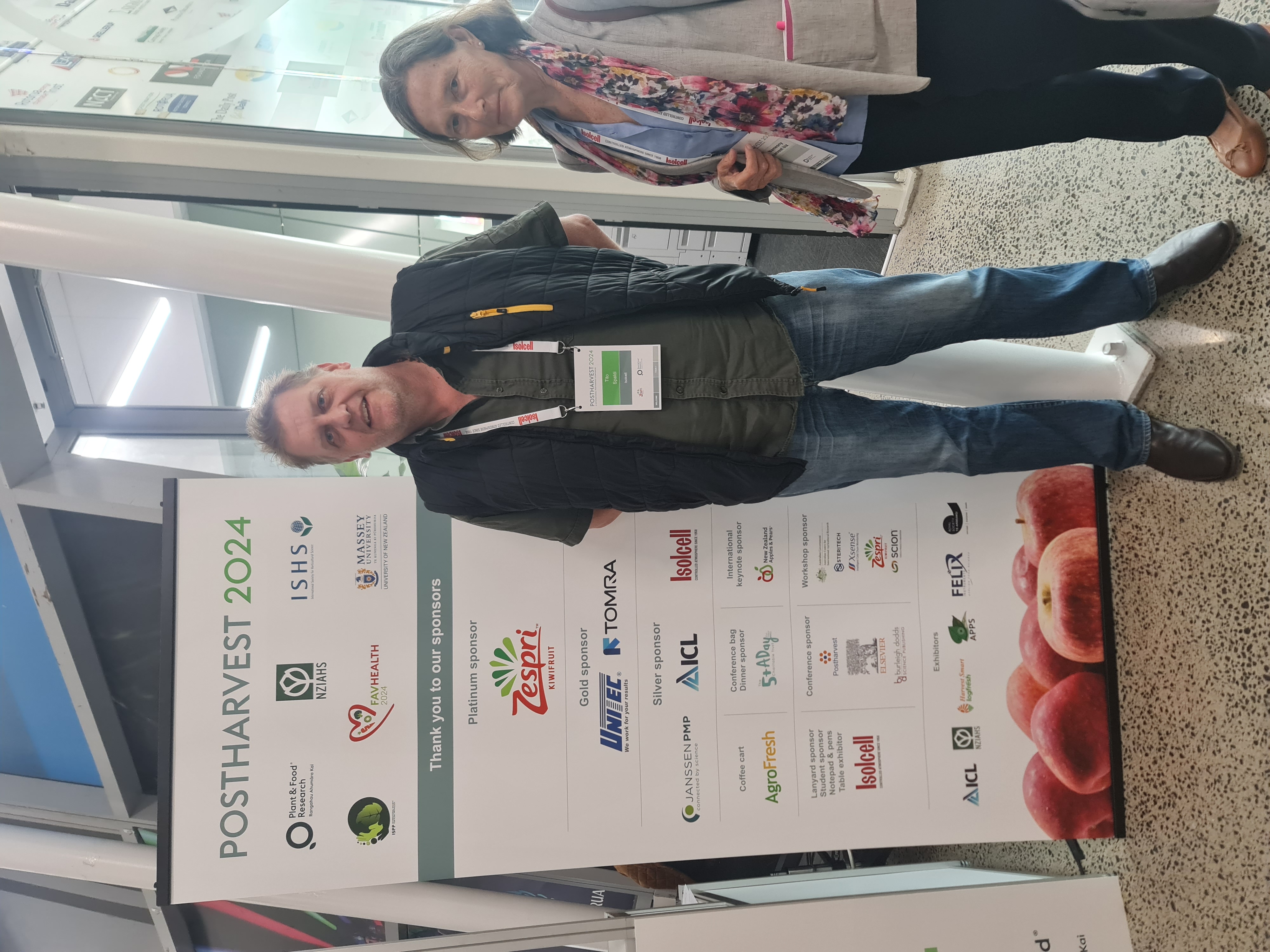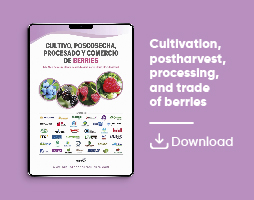News
Postharvest 2024, The Triple Symposium on Postharvest, Health, and Sustainable Food Systems
Food Waste and Mitigation Strategies, Genomics in Postharvest, Natural Product Development, and Fruits and Vegetables as Quality Phytochemical Sources

From November 11–15, 2024, the Postharvest 2024 symposium was held at the Rotorua Events Centre in New Zealand. After delays caused by the COVID-19 pandemic, the event drew a substantial audience, serving as a hub for scientists from around the world. It featured three prominent symposia:
- IX ISHS International Postharvest Symposium
- VII International Symposium on Postharvest Pathology
- X International Symposium on Human Health Effects of Fruit & Vegetables (FAVHEALTH 2024)

Allan Woolf, Plant & Food Research (right), at the ceremony honoring retired scientists with significant contributions to postharvest research. Ian Ferguson, shown in the image, was one of the recipients, recognized for his work as co-editor-in-chief of the journal Postharvest Biology and Technology.
Organized by Allan Woolf (Plant & Food Research) and Andrew East (Massey University) under the auspices of the International Society for Horticultural Science (ISHS), the symposium was supported by key organizations such as the New Zealand Institute of Agricultural & Horticultural Science (NZIAHS) and the International Society for Plant Pathology, alongside various contributors.
The opening address was delivered by Prof. Giancarlo Colelli, Chair of the ISHS Postharvest Group, who highlighted the ISHS’s pivotal role in fostering the global dissemination of scientific knowledge.
The event brought together 365 participants from 14 countries and hosted an impressive array of activities, including approximately 300 oral presentations, 100 posters, 11 workshops, and 5 excursions. Abstracts and posters are available for download from the Programme section of the Postharvest 2024 website.
New Zealand institutions made significant contributions through oral and poster sessions. Participants included Plant & Food Research, Massey University, the University of Otago, Lincoln University, the University of Auckland, Fonterra Research and Development Centre, Riddet Institute, AgResearch Limited, and Zespri Innovation Ltd. Additional contributions came from organizations such as the Kiwifruit Breeding Centre, Callaghan Innovation, Canterbury Agriculture Science Centre, Fooding Global (noted for its Vitamin D-rich fungi products), Scion (developers of real-time sap ion sensors), and Agrofresh New Zealand.
Key sponsors of the event included Zespri, Tomra & Compac, Unitec, Janssen PMP, Isolcell, and ICL.
Topics explored at the symposium ranged from food waste reduction and genomics in postharvest science to sustainable food production and strategies for managing postharvest diseases.

At Postharvest 2024, researchers from the IVIA (Valencian Institute of Agricultural Research), Miguel Hernández University of Elche, Polytechnic University of Valencia, University of Granada, IFAPA, IHSM (Institute of Subtropical and Mediterranean Horticulture "La Mayora"), as well as companies such as Agrofresh, Productos Citrosol, Masso, and the Cooperativa Agrícola Nuestra Señora del Oreto Coop., Cooperativa Agrícola de Callosa d'en Sarria, and Fresas Nuevos Materiales, participated directly or through co-authored works.
Food Waste: An Invisible Iceberg
In New Zealand, a dedicated office advises the Prime Minister on addressing food loss and waste, reflecting the nation's commitment to sustainability. Juliet A. Gerrard, former Chief Science Advisor to the Prime Minister and currently a professor at the University of Auckland, shared insights into the initiatives in New Zealand, which she referred to as Aotearoa—a Māori term originally used for the North Island but now commonly applied to the entire country.
Gerrard outlined the complexities and trade-offs involved in reducing food loss and waste across the supply chain. She emphasized the gaps in knowledge and how research and innovation can drive the transformation towards a more sustainable and less wasteful food system.
Research in New Zealand shows that 40% of food is wasted, translating into wasted water, energy, and other resources, alongside significant greenhouse gas emissions. Gerrard described food waste as an "iceberg problem," with most of its impacts hidden beneath the surface. Households alone are estimated to throw away NZD 600 (€330) worth of food annually.
New Zealand aims to eliminate food waste by 2040 through a multi-pronged strategy that prioritizes prevention, rescuing food for human consumption, developing new products, utilizing food as animal feed, recovering materials, recycling nutrients, recovering energy, and resorting to disposal only as a last step. These strategies are detailed in the publication Preventing Food Loss and Waste in Aotearoa New Zealand, which offers a roadmap for action tailored to specific circumstances.
Consumer education is vital in addressing food waste. Providing accurate information, such as when packaging is beneficial or how to manage leftovers, can empower individuals to make sustainable choices. Supermarkets play a crucial role in this effort by guiding customers toward informed decisions.
Currently, research contributes relatively little to food waste reduction but holds immense potential. Areas of focus include extending the postharvest life of fruits and vegetables, preserving nutritional value, valorizing food waste into new products, enhancing food safety, advancing processing techniques for organic resources, and improving methods such as anaerobic digestion for waste conversion.
To realize these goals, coordinated efforts between public and private sectors are essential. Immediate opportunities for research and innovation include precision horticulture and better planting/harvesting techniques, the development of new cultivars, smart packaging to extend shelf life, and assessing the cost-benefit of packaging for different products.
New Zealand’s holistic approach underscores the importance of innovation, education, and collaboration in addressing one of the most pressing environmental challenges of our time.

Using Genetics to Improve Postharvest Quality
Efforts to extend the shelf life and maintain the postharvest quality of fruits and vegetables typically involve early harvesting, controlled atmosphere storage, and genetic modifications that delay ripening and/or impact texture. While these methods are effective in preserving shelf life and meeting the demands of the fresh produce market, they can sometimes compromise quality.
James Giovannoni, from USDA-ARS and the Boyce Thompson Institute in the USA, explains that advances in understanding genes and genomes have revolutionized plant breeding, offering a wide array of candidate genes to address various challenges in plant production, yield, and postharvest quality.
Biotechnology holds promise through two main approaches: genetically modified organisms (GMOs) and gene editing.
In large-scale crops such as corn, soybeans, cotton, sugar beets, canola, and wheat, GMOs are widely used. However, for crops with lower global economic value, fewer genetically modified products have reached the market. One example is the genetically modified papaya, engineered to resist the papaya ringspot virus, which accounts for 85% of the papaya cultivated in Hawaii. Other examples include the Arctic apple, which resists browning, and a pink-fleshed pineapple that commands higher market prices (developed by Fresh Del Monte, this variety is also sweeter). Additionally, some genetically modified tomatoes are available, primarily for hobbyist markets.
Giovannoni used the tomato as an example, noting that its genome was first sequenced in 2012. Today, there are 75 sequenced genomes of cultivated tomatoes, as well as many wild tomato genomes, presenting great potential for improvement. At USDA-ARS, they have accumulated 1,777 accessions and sequenced 140 genomes.
A greater understanding of plant genomes opens new possibilities for improving the traits of fruits and vegetables. Modern biotechnological tools allow for the easier transfer of desirable traits into elite germplasm, creating crops that capitalize on natural genetic diversity for improvement. These crops are not genetically modified in the traditional sense, but rather enhanced through knowledge-driven breeding techniques based on genome sequencing.

Soil, a Natural Asset
Brent Clothier from Plant and Food Research in Palmerston North draws an analogy to the economic world, explaining that nature’s assets include soil, vegetation, biodiversity, and water. Along with the climate, these elements are the foundation of human well-being.
The concept of natural capital blends economic thinking with ecological principles, viewing nature's resources as valuable capital. In the economic world, interest and returns flow from capital. Similarly, in the ecological world, ecosystem services flow from our natural capital reserves, and these services are of immense value. It is essential that we protect and preserve these natural assets.
In Franklin Hiriam King’s 1911 book Farmers of Forty Centuries, King visited Japan, Korea, and China in 1909 to examine the agricultural practices of about 500 million people who had inherited knowledge passed down over 4,000 years. His insights foreshadowed modern perspectives on ecosystem services.
King emphasized the importance of organic waste management, including waste from inadequate (then) postharvest handling, as crucial for replenishing organic matter in the soil. He concluded that the continuous cultivation of these lands for 4,000 years was only possible by reinvesting organic waste back into the soil. King also noted that soil without carbon is inert. The persistent application of organic waste, he argued, not only maintained the soil’s organic matter but also helped preserve its structure.
The presence of organic matter in the soil creates pores, increases carbon content, and facilitates the mineralization of carbon. It also helps prevent the loss of nitrogen, which, when captured by the soil’s carbon, is reduced by 10%.
The speaker also raised concerns about the impact of desalination on water resources. A study he conducted in the United Arab Emirates revealed that aquifers are being salinized due to discharge from desalination plants, which contain three times the salinity of seawater. The salinity of water in a salinized aquifer can reach as high as 25 dS/m.

Microorganisms in the Pathosystem: A Tool for Effective Disease Management
Advancements in tools and technologies have greatly enhanced our understanding of plant-microbiome interactions and the mechanisms behind disease development. Research has shown that non-pathogenic microorganisms can collaborate with pathogens to facilitate infection and exacerbate disease severity.
The concept of the "pathobiome," introduced by Samir Droby from the Agricultural Research Organization in Israel, acknowledges the complexity of postharvest disease development. It suggests that, beyond the pathogen itself, other components of the microbiome can play a crucial role.

The pathobiome can influence disease onset by shifting the plant’s resistance to susceptibility. A healthy fruit maintains a balanced microbiome, but both biotic and abiotic factors can disrupt this balance, leading to dysbiosis and potentially triggering disease.
Instead of focusing solely on "controlling" disease, the speaker emphasizes the importance of "manipulating" it. His research demonstrated that, within two days of inoculating Penicillium expansum into an apple wound, yeast and fungi levels increased. This highlights the potential for manipulating the microbial composition as a tool for disease management.
Additionally, research explored how fruit exudates, such as compounds released from the fruit surface, affect the microbiome. When a fruit is wounded, it releases volatiles as signals to the environment. The pathogen detects these signals and begins spore growth toward the wound, likely attracting other microorganisms as well.
Given the microbiome's dynamic and adaptable nature in response to pre- and postharvest treatments, the speaker suggests rethinking the traditional approach of using a single antagonist for biocontrol.

Challenges of Natural Solutions for Postharvest Use
Postharvest control of pathogens primarily relies on traditional preservation methods, often involving synthetic pesticides. However, these are increasingly under scrutiny, driving the growing demand for naturally derived alternatives. Wendy Schotsmans of Janssen PMP, in her presentation, explained that despite the rising interest in green chemistry, such natural treatments rarely make it to the market.

The evaluation process typically follows several key stages. The first step is a theoretical assessment, which involves gathering relevant information about the new natural solution. This includes reviewing scientific literature, patents, safety data, existing regulatory approvals, and certifications.
The second step involves a more detailed high-level evaluation. A sample of the new product undergoes several tests, starting with efficacy trials, which include controlled in vitro and in vivo studies to determine potential effectiveness and identify any phytotoxicity issues. At the same time, stability and compatibility tests are performed to understand how the product behaves under various conditions.
In parallel with these laboratory evaluations, other departments initiate their own high-level assessments. Legal and regulatory teams assess the requirements, timeline, and costs for registering the product in key markets and crops, while the supply chain team evaluates production processes and the feasibility of scaling up to commercial volumes. The commercial department simultaneously investigates the market potential, demand, and interest in the product.
Only if the high-level evaluations are positive does the process move forward to more specialized development. This phase includes additional efficacy trials, field tests, toxicological and ecotoxicological evaluations, residue testing, environmental behavior studies, registration strategy, scaling-up production, packaging considerations, and transportation logistics.
Throughout her presentation, Schotsmans emphasized where the obstacles lie and why many natural products fail to reach the market. She also underscored the need for deeper research into the commercial viability of potentially useful natural solutions in postharvest management.

Phytochemicals in Fruits and Vegetables for Health
Fruits and vegetables are essential components of the human diet, rich in phytochemicals that promote human health. Regular consumption of these foods is often linked to reduced inflammation and a lower risk of chronic diseases such as cardiovascular diseases, as well as improved immune function and mental health.
Pre- and postharvest practices play a significant role in influencing the levels of health-promoting phytochemicals in fruits and vegetables. These practices, which can be viewed as part of a "harvest-to-health" approach, include the selection of high-quality cultivars, optimization of growing conditions, harvest timing, and postharvest handling strategies aimed at boosting phytochemicals that benefit health.
Bhimanagouda Patil from Texas A&M University shared research conducted in collaboration with Deepak Kumar Jha and Vikas Dadwal, focusing on the phytochemicals present in cultivars of onion, melon, grapefruit, and tomato, and their implications for health.
For example, in ripe grapefruit, D-limonene and furanocoumarins were found to inhibit crucial liver isoenzymes CYP 3A4 and CYP 1B1, which are essential for drug metabolism. In cell culture studies, citrus bioactives, including limonoids (such as limonin and other derivatives) and nomilin, effectively inhibited the proliferation of colon and breast cancer MCF-7 cells and promoted apoptosis by suppressing inflammatory signaling mediated by NF-κB.
Additionally, they discovered that citrus juices help increase bone density and may prevent osteoporosis by modulating antioxidant enzymes and lipids in orchiectomized rats.
In their research on nanoencapsulation of onion seeds, higher levels of di-/monoglucosides of quercetin were observed, and these bioactives reduced the severity of oxidative damage, which prior studies have shown to have anti-atherosclerotic effects both in vitro and in vivo.
Lycopene, a beneficial carotenoid, was shown to inhibit the proliferation of prostate cancer cells in rats. In ongoing studies on tomatoes, they enhanced lycopene biosynthesis by supplementing them with UV radiation in greenhouse conditions.
Currently, they are exploring the prebiotic potential of phytochemicals for gut health. These investigations aim to assess whether phytochemicals can enhance the growth of beneficial gut microbes or increase the production of microbial metabolites, such as short-chain fatty acids and antimicrobial compounds, to combat foodborne pathogens.
Future research will focus on intestinal microbial metabolomics to gain a deeper understanding of gut bacterial activity and the broader health benefits of fruits and vegetables.

Related news









.png)








